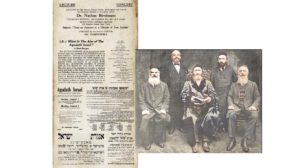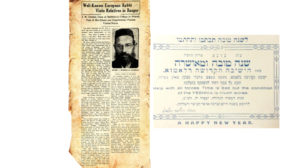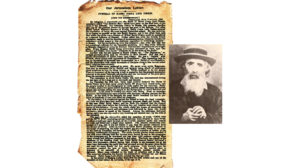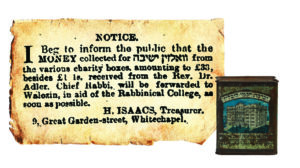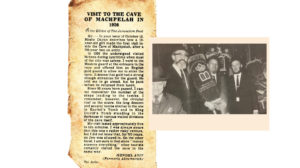No Caving In

Dr. Gershon Bar-Kochva chisels away at history in Chevron
BONUS! Videos throughout the article
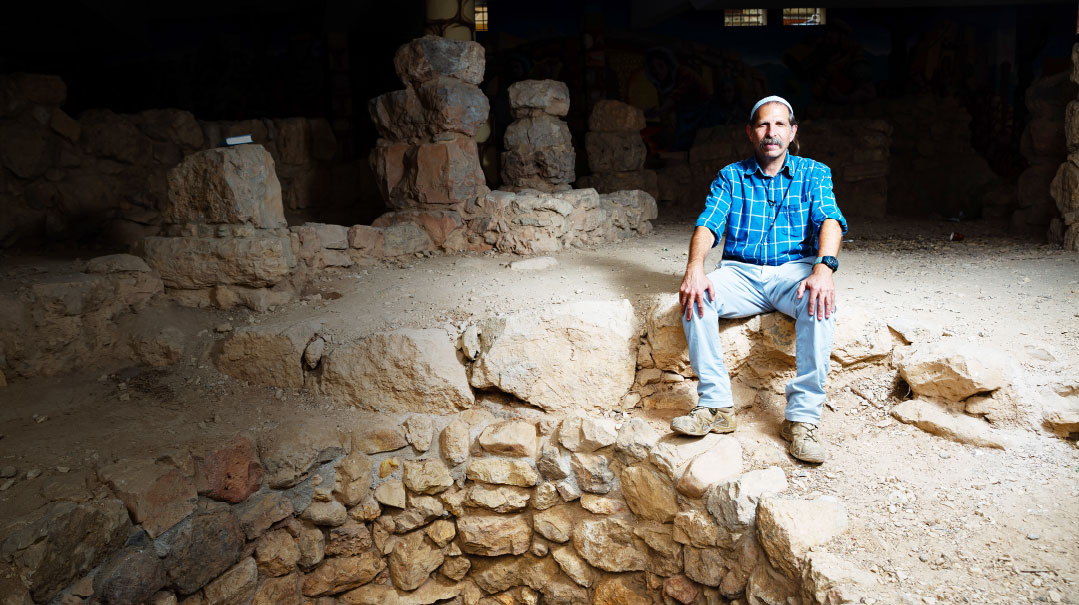
Photos: Elchanan Kotler | Video: SC Media Productions
W
hen a secular Israeli archaeologist was literally moved to tears during a tour by Dr. Gershon Bar-Kochva a few years ago,
Chevron resident and veteran historian Dr. Gershon Bar-Kochva came face to face with the transformative power of the Mearas Hamachpeilah.
“It was a Chol Hamoed Pesach, there were thousands of people davening all around, but this researcher from Jerusalem was just there to see our latest findings,” says the researcher and archaeologist. “We began the tour, pointing out the massive structure built by King Herod and the subsequent building during the Crusaders and the Mameluke period, but when we stopped next to Ulam Yaakov — the hall above where Yaakov Avinu is buried — I saw I’d lost his attention. He wasn’t with me anymore. Looking around, this secular man suddenly started to cry, saying to himself, “If my savta would know where I am now!”
It’s the middle of Israel’s second coronavirus lockdown. Mask-wearing soldiers guard the largely empty building, and the torrent of visitors passionately saying Tehillim has been reduced to a trickle, but I’m admitted to Mearas Hamachpeilah with a guide no one argues with. Dr. Gershon Bar-Kochva’s handlebar moustache and flowing peyos are evidence of the eclectic influences on his life. The slight, youthful build is testament to five decades spent climbing into IDF tanks as well as straddling the ruins of ancient Chevron, peeling back the layers of the holy city’s history to reveal groundbreaking findings.
“Do you know where Avraham Avinu lived? We know from the Chumash that it was in Elonei Mamrei, but the question is, where is that exactly? I belive it’s just over there,” he says, gesturing to the normally full car park just in front of Mearas Hamachpeilah. “The standard claim, including that of the Christians, is that it’s a few miles away by the entrance to the city, but I have proof that they’re wrong, and it was really over here.
“Look at that hilltop there,” he continues, pointing to a sunlit ridge overlooking the depression where Herod’s fortress-like complex lies, known as Tel Roumeida or Admot Yishai, one of the Jewish complexes in the ancient city. “That’s Tel Chevron, where we’ve found the remains of the original city. The massive stone walls that have been excavated lead to a gate — which could be the “sha’ar” where Efron sold Mearas Hamachpeilah to Avraham to bury Sarah Imeinu.”
Bar-Kochva stands on giant’s shoulders; his archaeological predecessors include Sir Charles Wilson — of Wilson’s Arch fame at the Kosel — and the Victorian-era Palestine Exploration Fund. But in today’s Chevron, archaeology is far more than just history: Each Hebrew inscription, every Crusader motif uncovered has geopolitical overtones. With the Muslim Waqf claiming Mearas Hamachpeilah as an Islamic shrine, the painstaking revelation of more and more Jewish history found in the original structures undermines that narrative. And so, the IDF’s Civil Affairs Directorate — anxious to preserve the delicate status quo in Chevron — keeps a watchful eye on Bar-Kochva’s work.
Bar-Kochva admits, however, that even after decades researching Mearas Hamachpeilah, “I can say that we’ve only uncovered about 30 percent of its secrets.”
Wow Moments
Gershon Bar-Kochva’s fierce love of Chevron was actually born far away from the ancient city, in the modern bustle of New York. “My mother came to Israel as a teen in the ’50s, and she decided to stay,” he says, “but when her parents called her to come home to America, she decided to make a fait accompli and get herself drafted to the IDF — that way she’d be unable to leave. They stopped her at the last minute and sent her home to America.”
Meeting a like-minded follower of Jabotinsky’s hawkish Revisionist Zionism, the couple married, and in 1963 Gershon was born. In 1970 they headed back to Israel. Chevron had been liberated three years before, and Gershon’s father, Chaim, made sure to visit Mearas Hamachpeilah — and even photographed the Herodian drainage system that his son would later study.
When the family first moved to Israel, their name was Kessler. But later, when Gershon was drafted into the IDF’s armored corps after studying for a time in Yeshivat Hesder Nir in Kiryat Arba, he discovered something unwelcome about his surname.
“I learned that there was a World War II Luftwaffe general called Ulrich Kessler, and so I decided to change my name,” he says. “And if we were already talking about a military personality, then I wanted to choose Bar-Kochva, whose military leadership in the revolt against Rome I’d felt a connection with.”
Equipped with a new martial name, Gershon Bar-Kochva rose up the ranks to become a lieutenant-colonel. At the same time, he married Shlomit, whose father Moshe Zar is a legendary figure in the settlement movement, responsible for buying large parcels of land in Yehudah and Shomron from Arabs. The young couple settled in Chevron, and Gershon soon decided to probe what lay beneath his hometown.
And that’s how he came to search for the site of Elonei Mamrei. “If you open up a Chumash to Lech Lecha,” he begins, holding a Tanach and falling into the lecture mode that he uses in Midreshet Chevron, “you read of Avraham’s nephew Lot being kidnapped by the four kings, and a messenger coming to tell Avraham ‘who was living in Elonei Mamrei.’
“For 1,500 years,” Bar-Kochva continues, “Jews followed the Christian tradition that identified the place where Avraham lived and invited in the malachim, with a site three kilometers north of Chevron known in Arabic as Ramat el-Khalil, meaning ‘Hill of the Friend,’ referring to Avraham’s closeness to G-d. There are records of Jews praying there in medieval times, but I’ll tell you why that can’t be the place. Chazal tell us that when Avraham went to prepare a meal for his angel-guests, the calf ran away, and Avraham ran after it, finding it by a cave, which turned out to be the burial place of Adam and Chava. Does it make sense that he ran three kilometers after a calf? It’s more logical that he lived near the cave, and that it ran into his backyard.”
Pointing to the ring of hills around Mearas Hamachpeilah, Dr. Bar-Kochva clinches his argument: “Look at the topography. All around here are hills. Where are the ‘plains of Mamrei?’ The car park in front of the Mearas Hamachpeilah is the only naturally flat area within distance. We think that the place where the buses and cars park when people come to visit is actually where Avraham and Sarah lived.”
Although inconclusive from a mesorah or archaeological point of view, it’s a dramatic claim. And with that peroration ringing in my ears, Dr. Bar-Kochva turns to the policemen manning the turnstile security barrier leading up to Mearas Hamachpeilah.
It seems that old-style Israel protektziya is needed to get in, due to the coronavirus limits. But around here, Bar-Kochva is a name that opens doors. “Gershon!” the brawny officer on duty greets him, as his subordinates crowd round. “How are you? I still remember your talk.”
Gershon Bar-Kochva ushers me up the Jordanian staircase and through the Crusader doorway of Mearas Hamachpeilah with the manner of a host welcoming someone to his home. But whereas this conscientious historian can show you the Crusader and arabesque decorations that the landlords over the last millennium left behind, his life’s work is to reconnect to the original Jewish homeowners.
“In all my years of doing this research,” he says “there have been few moments when I shouted ‘wow!’ But one of them happened when I found the original gates to this giant structure that Herod built.”
One Door Opens
Of all the questions that have puzzled Mideast researchers over the last centuries — from Charles Wilson and Conrad Schick of the Palestine Exploration Fund in 1882 to this day — the biggest one was the mystery of the missing doorways. Today’s entrances are carved through by the Crusaders, but for generations it was unclear where the original doors were. It was so troubling that in 2008, archaeologist, Dr. Yitzhak Magen, surveyed 150 years of research and concluded: “This leads us to an assumption that at first glance seems illogical and baffling. There were no gates in the Second Temple period Cave of Machpeilah enclosure. This was a marker over tombs not initially made to receive visitors.”
“In other words,” says Bar-Kochva, “Dr. Magen felt that King Herod built a gigantic sealed matzeivah over the original cave, and there were in fact no entrances to what we know today as the Mearas Hamachpeilah structure.
“That was until I found the entrances.”
Bar Kochva’s research focused on two small entrances that had been presumed to be of Muslim origin. One, which he’s named Shaar HaImahot because it emerges near the tziyunim of Sarah, Rivkah, and Leah, is the Muslim entrance to the building, off limits to Jews for the last 25 years. Muslim tradition claims it was broken through by a Fatimid Sultan in the 10th century. The other entrance, which Bar-Kochva calls Shaar HaAvot because of its proximity to the tziyunim of Avraham, Yitzchak, and Yaakov, is also claimed by Muslims to have been broken through at the same time.
But Bar-Kochva’s painstaking examination of the two modest-sized entrances — presumed to be of Muslim origin — showed that underneath the stone fascia there was another, original doorway. Most importantly, the edges weren’t jagged, as they would be had the doorway been broken through at a later date, but smooth, proving that these entrances were part of the original Herodian construction.
Archaeologists, though, were skeptical. “We know that Herod built everything on a massive scale,” Bar-Kochva explains, “so why, they asked, would he build small entrances to Mearas Hamachpeilah instead of grand doorways?” But Bar-Kochva the sleuth wouldn’t give up, and he found empirical proof.
“I took the pictures of the entrances I’d uncovered to archaeologists specializing in Herod’s building, and without telling them where the pictures were from, asked them whether they knew of anything similar. One researcher said, “Of course, we have one of those entrances on the Har Habayis, and there’s no question that Herod built it!”
If, as many researchers affirm, the actual burial sites of the Avos and Imahos are several hundred meters through winding pathways, and Jews during Herod’s time used to daven in those underground labyrinths, it might make sense that there were no large doors, because the monument — today’s Machpeilah complex — itself was little used. Worshippers instead made their way all the way down into the passages close to the area of the original cave.
As we enter the room just off the main part of the Machpeilah complex, Bar- Kochva stops. “Do you know where we are?” he asks with a trace of suppressed excitement in his voice. “In the fifth century, there was a letter written that mentions a shul next to the tziyun of Yaakov Avinu. We didn’t know where it was, while the Muslims claim that no shul ever existed. All that changed three years ago.”
Pointing to the massive, deeply veined masonry built by Herod, he says that the Waqf, together with Israel’s Antiquities Authority, began to strip away the original three-centimeter deep layer of plaster from Mameluke times, 800 years ago. “Every day, I came to watch as they worked to see what we’d find. And look what I discovered. Here, high on the walls, etched in Hebrew in the stone are two words: ‘Rabbi Yaakov,’ and further along, the name ‘Tanchum.’ And if you look along this other wall,” he points, “you’ll even find ancient kvittlach. Jews came here from Greece in the fifth century and left a record of their names and what they were davening for.”
Over the Wall
Just a few hundred meters away from the protective cordon of Mearas Hamachpeilah is one of the more precarious places for a Jew to visit. It’s the Chevron casbah or wholesale marketplace, a Hamas stronghold. Some of the masonry on the storefronts still bear a Magen David or a carved-out indentation for a mezuzah, testament to the fact that before the massacre of 1929, this was, for at least 500 years, a Jewish residential area. But today, soldiers patrol in full combat gear, and the popcorn sound of distant gunfire is not unusual.
All of which makes the peace in the renovated Avraham Avinu neighborhood and apartment complex just a few streets away so deceptive. Arab children sit in front of some deserted-looking stores, while Jewish children play in the compound around the Avraham Avinu shul, just across the road.
This tense standoff means that much of the area around Mearas Hamachpeilah is frozen in in the post-Six Day War status quo. Most of the buildings of the old Jewish quarter — those that haven’t been redeemed and restored — are crumbling, and in the Chevron tinderbox, geopolitics prevents any restoration. But for Gershon Bar-Kochva, this area means that the wonders of Jewish history are there, waiting to be revealed.
Behind a long wall with gaps instead of windows, is a large pool filled with high reeds. To the eye, it looks like an overgrown ruin. But for Bar-Kochva, this may be a link to the King of Chevron — Dovid Hamelech himself. And this location, where he’s now spending significant time in research, is a perfect example of his methodology: He’s no Bible-thumper, jumping to conclusions to fit his preconceptions. Instead he combines archaeological evidence and cautious inference combined with a reading of Torah as history to build a case.
“When King Shaul was killed in battle, his son Ishboshes was appointed in his place,” he says. “But two of Dovid Hamelech’s soldiers — Reichav and Baanah — wanted to please their king, and slaughtered Ishboshes during his afternoon rest. They brought his head to Dovid, fully expecting a generous reward for killing his enemy. Instead Dovid Hamelech reacted angrily, accusing them of killing a tzaddik, defenseless in his sleep, and they were condemned to death themselves.”
Reichav and Baanah were executed, as Sefer Shmuel (Shmuel II:4) says, by “the pool in Chevron,” and local Jewish tradition considers this place that very pool. But on the other hand, the Palestine Exploration Fund, on their 1882 visit, accepted the local Muslim tradition that the pool was built thousands of years later, by the Mameluke ruler Sultan Qalawun.
And so remained the archaeological consensus for 150 years — until just six months ago, when Bar-Kochva struck gold.
“I was looking at the steps leading down to this pool, when I suddenly saw a symbol that had been missed by previous archeologists, probably because the water level used to be much higher,” he says. “It was unmistakably from the Crusader era. It was a fleur-de-lis, which was an emblem of French King Louis VII, dating it to the Second Crusade, or 150 years before the Muslim Mamelukes.”
Having proven once again that a particular finding definitely predates the Muslim era, Dr. Bar-Kochva followed the logic. “We know from Tanach that there was a pool here. We know that topographically, rainwater has to drain down into this valley. And we can assume that the Crusaders would have fixed up and improved an ancient water source, instead of constructing a new one.
“So, can I prove that this is Dovid Hamelech’s pool? No. But it’s a very persuasive argument,” he says.
Just around the corner, another story appears out of the ruins. Next to an arch built by Sultan Baibars, the fearsome nemesis of the European Crusaders, is a ruined hamam, or bathhouse. For hundreds of years, it served Sephardim and Ashkenazim as both a place to wash and a mikveh.
In fact, according to Dr. Bar-Kochva, this ruin has a place of honor in halachic history. “According to the Shulchan Aruch, a hot mikveh is invalid ,” he explains. “But Sephardic custom is that it’s permitted, and that halachic change traces itself back to the great rabbanim of Chevron, including the Meleches Shlomo, the 17th-century Rabbi Shlomo Adani. He noted that this custom was first pioneered in his hometown, which makes this hamam a major halachic point of interest.”
That halachic pedigree piqued Bar-Kochva’s interest and led to another “aha!” moment. “I wondered when it was built but couldn’t find anything but an unknown symbol on the stones. Then one day I was davening vasikin at Mearas Hamachpeilah, and I looked upward when I said Shema. I opened my eyes and — boom! — I saw it. There was the same eight-sided symbol on the roof. Now, we know for sure when that part of the Mearah is built — in 1265. So now I knew when the bathhouse was built as well.”
Connected Souls
It’s mid-afternoon when we head out from the Avraham Avinu neighborhood, past watchful soldiers along a road that winds steeply uphill. Our destination is the neighborhood known as Tel Rumeida, an enclave with a few dozen Jewish families which recent archaeology points to as the original city of Chevron.
It’s not just the strategic location, commanding a view of Mearas Hamachpeilah below and the Chevron hills in the other direction that have brought families here, beginning with a makeshift trailor park in the late 1980s. It’s also the site of Tel Chevron — the location of the original city in the days of Avraham and Sarah (and which would later be the places of the kevarim of Yishai and Rus).
Excavations on the tel have unearthed dramatic findings. Once again, the Muslim narrative denying a strong Jewish connection to the city has been disproven. Even the unpracticed eye can see wine and oil presses — and industrial-size mikvaos, suitable for large numbers of people at once.
“Where would you need agricultural products to be produced in a state of purity necessitating this complex?” asks Bar Kochva, “We think that this place was used to produce wine and oil for the Beis Hamikdash.”
It’s hard to absorb the flood of revelations that this parcel of land generates, but the biggest surprise is just off the road. Stopping to greet the Civil Affairs soldiers, whose status quo enforcement is the bane of Bar-Kochva’s work, the archaeologist points to the exposed masonry underneath a mobile home.
“What do you see there?” he asks.
Following his finger, a breathtaking sight appears. A section of ancient wall, enormously thick, is immediately obvious. Next to it are a perfectly preserved set of steps.
“What we’re looking at is the original town of Chevron. Notice how the steps converge with the wall. If you continue on that angle, it’s obvious that they meet somewhere under the road that we parked on. What was there? It was the gate of the city, and if so, we’ve found the exact place where Efron, the mayor of the town, sold the Mearas Hamachpeilah to Avraham to bury Sarah.”
Gershon Bar-Kochva has shared this revelation hundreds of times, but his excitement is still palpable as he repeats it again.
“After Sarah had been buried, Avraham came back, as the Torah tells us, to say a hesped for her. According to a midrash, the eulogy he said was Eishes Chayil. And now, standing in this place, we understand why the song refers multiple times to the ‘gate’ — ‘Noda bashearim baalah… Vayehaleluha bashearim maaseha’ [Her husband is known in the gates… Her deeds will praise her in the gates].
“In front of which gates should her actions be praised?” asks Bar-Kochva. “Perhaps, in front of the very gates we see here!”
It’s as if he has a secret he wants to share. “People go to Amuka, to Uman, to many other places to pray to find a zivug,” he says. “But I met my wife here in Chevron. And you know why? Because in this place of couples, Avraham and Sarah, Yitzchak and Rivkah, Yaakov and Leah — this is the ultimate place to find connection.” —
(Originally featured in Mishpacha, Issue 835)
Oops! We could not locate your form.
